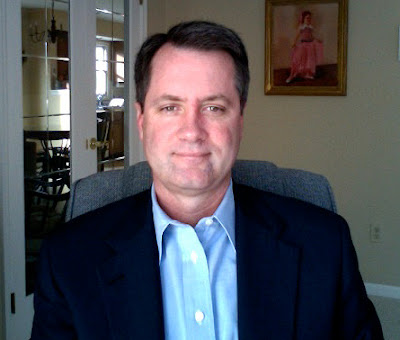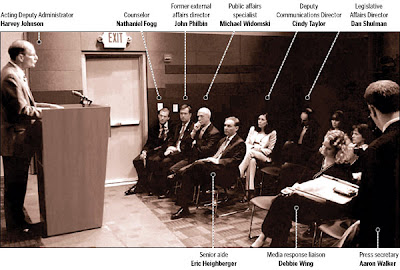I sat down with John “Pat” Philbin, APR, Ph.D., former Director of External Affairs at the Federal Emergency Management Agency (FEMA). For Immediate Release Interview has posted the full audio of the interview with Pat Philbin simultaneously.
I have to admit that I also was pretty hard on FEMA about its staged press conference on October 23rd. It seemed to me at the time to be a junior mistake. So, when I heard that a senior communicator was found culpable, I questioned the ethics of the organization and wrote an essay for Bulldog Reporter outlining my concerns.
Photo credit: FEMA Image, Illustrated by the Washington Post (click to see larger image)
When I had the opportunity to talk with John Philbin directly, his direct and authentic style left me with a different impression of what happened. I am still concerned that many government agencies are not looking to communicate more directly with stakeholders, but I was dead wrong about the ethics of the lead communicator. Here is the story about how he fell on the sword for his superiors. After you read the interview (or listen to it on FIR), feel free to ask follow-up questions in this post. John “Pat” Philbin has agreed to stand by and answer any questions.
Listen to the full audio of the interview
Download the file here (MP3, 28.5MB)
John Pat Philbin Speaks Out
 John Pat Philbin has over 24 years of experience in public affairs. By any standard, his resume is impressive.
John Pat Philbin has over 24 years of experience in public affairs. By any standard, his resume is impressive.
So how could an otherwise stellar career be brought down in one day?
John Pat Philbin went to FEMA to help Admiral Johnson transform its business processes. His expertise was in public affairs, but his eye was on helping to change the processes that would make the agency more nimble and to ensure that the structural problems exposed during Katrina were fixed.
His focus was quite broad, and he relied heavily on his staff of just over 100 to help him with the mission. He mentioned that FEMA's six to eight person media staff take about 200 to 1,000 media calls every week.
In fact, the staff is trained to follow a very detailed protocol for communicating in these situations called the Emergency Support Function 15 (EFC 15 PDF, page A-18 or 33). This schedule calls for a daily briefing in Washington DC at 13:00, or 1:00 p.m.
The time for the fateful October 23 press conference was anything but arbitrary. As Pat points out in the interview, the failure was that the staff did not get out the notification by 12:00 noon, which would have given plenty of time for the media to arrive.
Clearly, this did not happen. And when it didn't, someone made the choice to go forward with the conference without the media, and that someone wasn't John Philbin, though he did become the fall guy.
“There is a public record that in my opinion is wrong.”
The day started out for Pat Philbin like many others. He and his staff had been working very long hours to provide information about the FEMA response to the California wildfires. Philbin was told that Secretary Paulison wanted the staff to hold the traditional 1 p.m. Washington Press briefing. Philbin made his assignments and headed to a scheduled situational briefing with people on the ground in California. He and Admiral Johnson headed directly to the press conference after that briefing and arrived late at 1:15 p.m.
Philbin looked around and saw there was no press and inquired to a nearby staffer about it. The staffer said the media were on the phone, but Philbin says he didn't know it was a one-way line. He admits to asking Johnson to clarify something.
On Thursday afternoon, two days after the press conference and Pat's last day in the office before he was scheduled to start a new job, he got an e-mail from columnist Al Kamen of the Washington Post.
He says that he sent the e-mail to the staff and said,
“You get back to him and tell him exactly what happened.”
“I come from a culture in the Coast Guard where bad news doesn't get better with age, you let it all hang out. You tell it all, you tell it now, you tell the truth and that was the attitude I brought with me to FEMA,” added Philbin.
The resulting article rightly took the agency to task for holding the staged press conference.
“The next day I spoke with [Washington Post reporter] Spencer Hsu and I told him, ‘I didn't orchestrate this, this is not how I do business. I would not condone or authorize it, but at the end of the day, I was the guy in charge and I regret that it happened.'”
The media were only too glad to find the guy who
would assume responsibility.”
The Hsu article might make you think it was Philbin's idea to hold the phony conference. However, a resulting investigation showed that the press secretary Aaron Walker made that decision.
According to the follow-up article about the investigation, on page A19 of the Washington Post on November 8, 2007, “Walker sent an e-mail telling members of the external affairs staff to be prepared to fill chairs and ‘to spur discussion' in the absence of reporters.”
In other words, John Pat Philbin followed the Crisis Communication 101 Rulebook, but he had the added complication of being essentially a lame duck. He had already turned in his resignation several days before the incident on October 18.
“When people asked, I directed the staff to tell the truth, and I said, ‘Look I didn't do it but I was the guy at the top,'” he said. “There is a [big] difference between a sin of omission and of commission,” he added.
“I didn't want to throw staff under the bus because I didn't know exactly what had happened and who had done what,” he added.
I think that is all you have in this business, your credibility.”
“I am a firm believer in…ethical behavior, because I think that is all you have in this business, your credibility, which is particularly troubling to me because that's what has been called into question [here].”
I asked Philbin where the reputation of the organization and the individual part ways and how he thought senior communicators could manage this?
“I don't think I understood the personal risk of going into an organization that has a huge target on its back,” he said.
He admitted that it is hard for FEMA to succeed no matter what they do since every misstep a can be used for a political purpose.
“This has been a very painful lesson for me to learn….when I invest, I invest completely. I tied the success or failure of FEMA to my own efforts.”
It took on a life of its own.”
“Once I did that [took responsibility], quite frankly that is all the press needed,” said Philbin. “The media said, we have the guy who did it — I beg to differ,” he said.
A quick Google search for “John Philbin” FEMA nets over 2,500 results and a similar search in the Google News archives brought back 22 publications. Yet according to Philbin, in the initial firestorm, he only spoke to three reporters.
Philbin noted that a senior editor at a leading newspaper told him that she didn't have time to do independent research into the incident.
“What happened to some of those Pulitzer Prize principles that required them to get…secondary source information?” wonders Philbin.
He also worries that people are not being allowed to make mistakes. And who among the communicators reading this haven't made their own mistakes?
“I can tell you this, it will never happen under me again if I am ever given the opportunity. To what degree do you put value on that? To allow people to make mistakes….Those that are allowed to make mistakes generally do not repeat them….So you are getting a pretty valuable person.”
The personal consequences have been pretty devastating.”
I asked Philbin if he had it to do over again would he take responsibility for the misstep.
“In hindsight would I do [take responsibility] over again? Yes, because I am a leader. I should have done some things differently, but when you trust and have confidence in your people and that they are doing what you think they are doing, stuff happens.
“Do you want someone who stands up [and takes responsibility] or someone who runs under a rock?”
Companies should communicate directly with stakeholders.”
Pat Philbin felt this incident taught him to be more skeptical about media coverage and to do a better job of building direct relationships directly with important stakeholders.
“Unfortunately, media today is more concerned with speed than anything else. The old model of using the mass media get information to those people that are most important isn't really effective anymore, because you can't be confident that they will verify the information [in their reporting] – they are going to run with it.
“I believe organizations need a way to communicate directly with their stakeholders…that is one way to mitigate the risk of this happening.
“Create trusting relationships [with stakeholders] so that when bad news hits at least they will be skeptical at first,” he said.
Pat's Takeaways
-
- Know your people, their capabilities, and their ethics. Furthermore, ensure the staff follows standard operating procedures. Do staff subscribe to a set of ethics that enhance relationships.
-
- Don't hesitate to stand up and rectify things immediately. “My personal interest was getting my face off of AOL out of concern for my family. It didn't work anyway.”
-
- Be more aggressive about getting the entire story out – push back harder. You have to lead, to be accountable, but also to engage in making sure the press isn't over-ascribing guilt.
- Understand your own limitations. The staff and Philbin had been working hard and long hours and he was even recovering from some minor surgery the week before. He admits he was looking ahead to his new position and not paying as much attention as he should have been.
There is much to learn from John “Pat” Philbin's experience. Pat has also agreed to stand by to answer questions in the comment stream of this post. Please keep comments constructive and respectful, though hard questions and concerns are welcomed.
UPDATES:
January 16, 2008 – PIER Systems, Inc., a provider of public information software for large-scale events, today announced that John P. “Pat” Philbin, Ph.D., formerly Director of External Affairs for the Federal Emergency Management Agency, has joined the company as Senior Vice President.
Today, Philbin is the President and Cheif Operating Officer of Crisis 1, a company that provides risk management consulting to senior executives at both public and private sector companies.

[…] executives have learned the hard way that the company or organization website can’t be their only online presence. Beyond a profile on […]